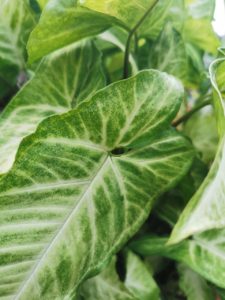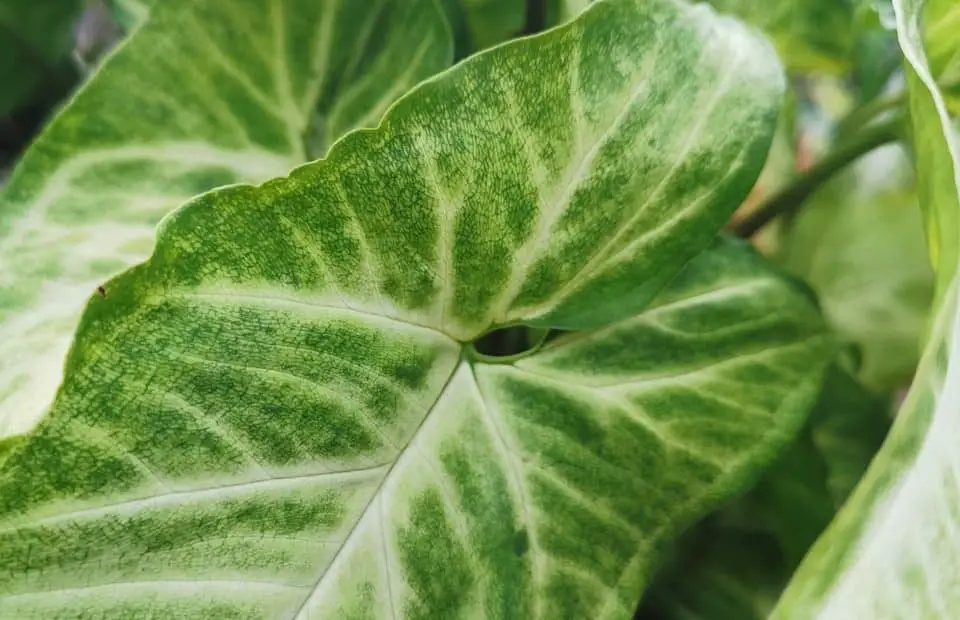Some links in the post are affiliate links and I get a commission from purchases made through some links found in the post.
Arrowhead plant, botanically known as Syngonium podophyllum, belongs to the family of Araceae. It is commonly referred to as the arrowhead vine.
It also goes by a lot of names including nephthytis, goose-foot vine, and African evergreen. These plants grow indoors.
They make your house and coffee tables beautiful and serve as natural air purifiers.
These have coarse-textured attractive heart-shaped leaves and give your indoors a fresh and green ambiance.
Being a vine, these plants can and do usually grow to varying lengths. These can be in the proper shape by a bit of trimming and pruning.
These amazing multifaceted plants are quite low maintenance and mostly grow in medium to low light.
What are the Arrowhead Plant Varieties?
It is a plant from tropical regions and has two known varieties growing in the wild:
1) Native to Costa Rica and Panama
2) Native to extensive American areas like Florida, Texas. And to Mexico, Malaysia, and Brazil.
Arrowheads have been grown extensively indoors for their beautiful leaves. They provide life to an empty desk or room.
The leaves have many shapes and patterns. They range in different color varieties too. The indoor varieties of arrowhead plant include:
 Albo Virens
Albo Virens- Berry Allusion
- Bold Allusion
- Cream Allusion
- Emerald Gem
- Emerald Green
- Exotic Allusion
- Five fingers
- Green gold
- Holly
- Julia Allusion
- Maria Allusion
- Painted arrow
- Pink Allusion
- Pixie
- Strawberry Cream
- Trileaf Wonder
- Variegatum
- White Butterfly
The Most Common Arrowhead Plant Problems
Although the arrowhead plant is a low-maintenance variety of plants, it can still be not achieving its full potential as you want it to. The plants need a loving green hand to grow properly.
The most common causes of having problems with your arrowhead plant are underwatering, overwatering, low humidity, temperature issues, inadequate lighting, fertilizer issues, humidity issues and pest issues.
To fix your arrowhead plant you need to figure out what the issue is first and then you can deal with it.
The causes listed above can lead to the following problems for your arrowhead:
- Curling of leaves
- Yellowing of leaves
- Browning of leave tips and stem
- Bleached leaves
- Lack of Growth
- Limping and drooping of leaves
- Plant becoming leggy
- Loss of variegation
- Brown spots
Why are my Arrowhead Plant Leaves Curling?
Arrowhead plants produce succulent and glamourous thick green leaves all year-round. For this reason, they serve as ornamental plants.
But the leaves may curl up and might look disdainful in appearance. The unusual curls can be due to many causes and the most common ones include:
1) Abnormal Temperature
Temperature either too high or either too low is dangerous for the plant.
Higher temperatures cause the burning of the leaves while the lower temperatures cause the plant to shrink.
They can also retard the rate of growth and can make the budding of new leaves very slow.
How to fix it:
The best solution would be to place your plant in a closed room. The temperature should be close to a normal room temperature of 25 degrees Celsius.
2) Nutrient Deficiency
Lack of essential plant nutrients can cause your arrowhead leaves to curl. Magnesium is one of the most important elements in them.
These nutrients help the plants maintain their arrow point-shaped appearance.
How to fix it:
Change the topsoil and administer a suitable fertilizer. But, do be cautious of over-fertilizing as the soil can become poisonous to your plant.
3) Insufficient light
The curling can also be due to inadequate light exposure. Less light causes less photosynthesis. This produces less energy to sustain the upright posture of the leaves.
How to fix it:
The problems caused with insufficient light can be cured very easily by providing more sunlight for your arrowhead plant.
If your plant is struggling due to light, trying using this to help regulate the lighting.
4) Low humidity
Low humidity is a common root cause of both curling and yellowing.
How to fix it:
Use a humidifier or humidifying try underneath the pot. Or you can place the pot in a good air moisture-containing room.
Company with other plants can also solve this problem in a jiffy.
Why is my Arrowhead Plant Looking Leggy?
An arrowhead plant looking leggy is normally due to it having a long thin stem.
The stem can bend or fall over due to excessive green leaves growing on the stalk. This can a result of various reasons:
1) Low light
In low light conditions, the plant may grow out in various directions. It does this in the search of light leading to a leggy appearance.
How to fix it
Place your plant in a well-lighted environment to prevent the problems caused by your arrowhead plant searching for light causing the plant to become leggy.
2) High nitrogen levels
Excess nitrogen amount can cause increased growth of the stems and causes the plant to become spindly and lengthy.
Thus, the thickness of the plant is compromised, making it look leggy.
How to fix it
Fertilize your plant without putting in too much fertilizer. Arrowheads require an acidic pH soil to grow.
They need nutrients but in balanced amounts to prevent unnecessary damage to the plants.
Why is my Arrowhead Plant Drooping?
1) Excessive Nitrogen
Excess nitrogen amount can cause a spurt of growth of the leaves. This can cause the slender stem to topple over due to the weight.
How to fix it
Prevent over-fertilizing the plant. The most suitable fertilizer for the plant is liquid.
2) Dry Soil
Arrowheads need moist soil to grow. Dry and parched soil causes the plant to lose its natural stiffness and droop.
How to fix it:
Soak the soil in water and let excess water dibble out from the bottom of the pot.
Care should be taken not to overwater the plant as it can lead to other problems as well.
If you need help watering your arrowhead plant, try using this automatic drip irrigation kit.
3) Abnormal Humidity
Low humidity levels cause your arrowhead to drop. It also is the root cause of many abnormalities as well.
How to fix it:
As already mentioned, humidifying the air to a suitable sultry environment is the most suitable for the plant.
Why is my Arrowhead Plant Leaves Turning Yellow or Brown?
Arrowheads can develop yellow leaves due to a variety of reasons. The most common conditions are as follows:
1) Natural Aging
The mature leaves turn yellow naturally. Their fate is unavoidable and it could just be a sign of the arrowhead plant getting old.
2) Abnormal Watering
Watering your arrowhead too much can result in the new leaves turning yellow. These plants prefer well-drained soil. The leaves also turn yellow if the plant isn’t watered properly.
How to fix it:
Water the plant, by letting excess water drain out. This is essential for preventing yellowing.
The plant does not like to grow in standing water. Watering the plant once or twice a week is enough to suffice its needs.
Again try using an automatic drip irrigation kit.
3) Insect Infestation
Scales, mealybugs, and aphids are the worst enemies of your arrowhead. They deprive them of essential nutrients causing your fronds to yellow.
How to fix it:
Isolate the infected plant from the healthy ones. Introduce natural predators like ladybugs to kill the pests.
Use a homemade natural spray containing neem oil, bicarbonate soda, and soap. This serves as an active killer of infestations.
4) Low Humidity
Arrowheads prefer high humidity air for growth. If the plant is grown in dry air, the leaves turn yellow.
How to fix it:
Place the plant in a humid tropical environment created if not available naturally.
5) Excessive Bright Light
Giving too much sunlight exposure causes wilting and burning of the foliage. This leads to yellowing.
How to fix it:
Placing the plant in filtered sunlight or low-light shady areas fixes most of your problems. This will rectify the yellowing in a few days.
Again this to help regulate the lighting
Arrowhead Plant Problems
 Many other problems your Arrowheads might face could include brown spotting on leaves. Brown spotting can be a byproduct of fungal and bacterial infections.
Many other problems your Arrowheads might face could include brown spotting on leaves. Brown spotting can be a byproduct of fungal and bacterial infections.
Bacteria causing brown spots include Pseudomonas cichorii, Erwinia, Xanthomonas campestris. Fungal infections by Ceratocystis Fimbriata or Rhizoctonia can also lead to spotting.
Aerial watering, overhead irrigation, and rainfall exposure can lead to brown spots. Fungicides should be used to treat these annoying fungal infections.
An arrowhead plant is common among the masses because of its variegated leaves.
Loss of variegation can be due to the absence of adequate bright light exposure.
The leaves may also become bleached and discolored due to direct light exposure.
Your arrowhead may fail to show adequate growth if deprived of adequate light and proper nutrition. Also, overwatering may retard the growth of your arrowheads.
The plant doesn’t grow that much in the winter season and watering needs to be curbed in this season.
Final Thoughts: How to Fix Your Arrowhead Plant Problems
Arrowhead plants are sublime plants that make a tropical addition to your indoors.
Though being quite low maintenance, proper care is always needed so they can thrive better and longer.
By reading all the above information, I am sure you will be able to handle all your Arrowhead Plant problems with little difficulty.
Before you go, here are some more related articles I encourage you to read below to help solve more of your gardening issues:
How to fix your norfolk pine problems.
What are the Common Problems With a Pilea
10 Most Common Fatsia Japonica Problems
Common Problems with Hydrangeas in Pots
How To Fix Your Oxalis (Purple Shamrock) Problems
How to Fix Your Ming Aralia Problems
About the Author:
Saad Ansar
Saad is an avid gardener himself and is a great lover of plants, animals, photography, & people. Currently, he is focused on photographing indoor plants & captioning beautiful outdoor sceneries. He writes and rewrites in-depth articles on nature and science.

